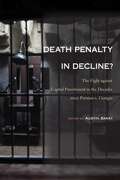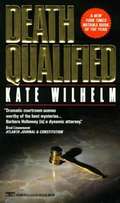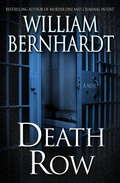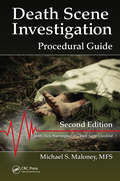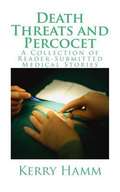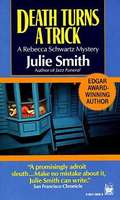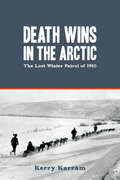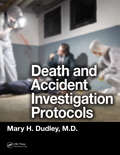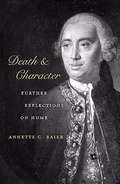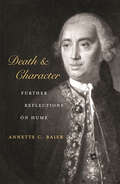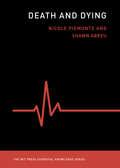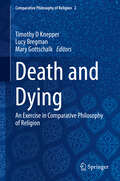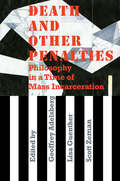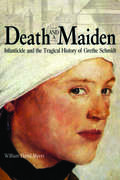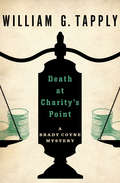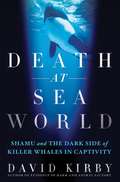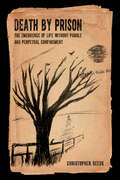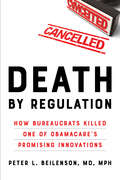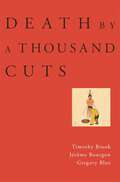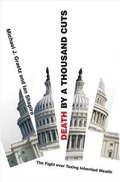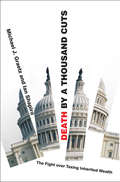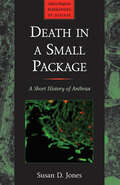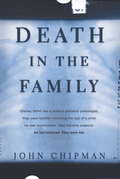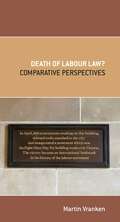- Table View
- List View
Death Penalty in Decline?: The Fight against Capital Punishment in the Decades since Furman v. Georgia
by Austin SaratHow have prospects for abolishing the death penalty changed since the 1972 Supreme Court decision, Furman v Georgia? The editor and contributors to Death Penalty in Decline? assess the contemporary death penalty landscape and look at the trends in and attitudes toward capital punishment and its abolition. They highlight factors that are propelling alternatives to the death penalty as well as the obstacles to ending it. At a time when the United States is undertaking an unprecedented national reconsideration of the death penalty, Death Penalty in Decline? seeks to evaluate how abolitionists might succeed today. Contributors: John Bessler, Corinna Barrett Lain, James R. Martel, Linda Ross Meyer, Carol S. Steiker, Jordan M. Steiker, and the editor
Death Qualified: A Mystery of Chaos
by Kate WilhelmWhat's the link between a powerful mind-altering computer program and two murders in the Oregon woods? Seven years ago Lucas Kendricks deserted his young family and took off for mathematician Emil Frobisher's research project in Colorado. Now, after one day's warning--he ordered a monster computer to be sent to his old address--he's back, and then, moments later, he's dead, along with a young woman he gave a lift to only a few hours before. The police think Lucas raped and killed the hitchhiker and was shot down by his tiny, sharpshooting wife Nell; but defense attorney Barbara Holloway, needled by her estranged father into coming back to him and the law (she'd been on the run from both for five years after a dose of professional disillusionment) is convinced that Lucas's death had more to do with the mysterious men who followed him from Colorado. Taking on her share of cliches--alliance with her curmudgeonly, reluctantly supportive father; opposition from prosecutor/former lover Tony DeAngelo; romance with mathematician Mike Dinesen (whom she's called in to make sense of the connections Lucas had with Frobisher, psychiatrist Ruth Brandywine, and computer expert Walter Schumaker)--Barbara delves into those blank seven years, and comes up with answers that are even scarier than the questions: a set of the most user-unfriendly computer disks in literature.
Death Scene Investigation: Procedural Guide, Second Edition
by Michael S. MaloneyThose tasked with investigating death scenes come from a variety of backgrounds and varying levels of experience. Whether a homicide detective, crime scene investigator, medico-legal death investigator, coroner or medical examiner, Death Scene Investigation: Procedural Guide, Second Edition provides the investigator best-practice techniques and procedures for almost any death scene imaginable, including for deaths occurring even under the most unusual of circumstances. This Second Edition is fully updated to include new coverage on shallow graves, human remains at crime scenes, poisonings, expanded coverage of projectile weapons, videography, touch DNA, death notifications, and a newly added chapter dedicated to sexual deaths. In addition, the book serves as an on-scene ready reference which includes instructions on procedure including the initial notification of a death, processing the scene and body, the investigator's role at autopsy, and analyzing the scene indicators to place evidence into context. Topics discussed include: Initial response and scene evaluation Death scene management including documentation, sketching, photography, videography, observations, and search procedures A special death investigation matrix that walks the investigator though a decision tree to help in ambiguous deaths Contains discussion of all manners of death, including accident, suicide, natural and homicide Coverage of recovery of human remains from open field, aquatic, and buried sites including estimating the time of death. Wound dynamics and mechanisms of injury that covers asphyxiation, sharp and blunt force trauma, chopping injuries; handgun, rifle, and shotgun wounds, electrical injuries, and more The bulleted format and spiral binding allows for easy use and reference in the field with sections that are self-contained and cross-referenced for quick searches. With its thorough and detailed approach, Death Scene Investigation, Second Edition will be a must-have addition to any crime scene and death investigator’s tool kit.
Death Threats and Percocet: A Collection of Reader-Submitted Medical Stories, Vol. 3
by Kerry HammIn the third edition of 'A Collection of Reader-Submitted Medical Stories,' Kerry Hamm presents her audience with stories submitted by first responders, hospital and SNF nurses, physicians, law enforcement, fire and rescue, obstetricians, receptionists, orderlies, and even a dentist. How did the young man receive chemical burns to his genitals? A bold (and stupid) stunt in court gets someone tossed in jail. Just how many women was that doctor sleeping with? All these questions and observations are hidden within this volume. Kerry's readers give her a run for her money on the stories they share, from the sad to the terrifying, and right down to the tears-rolling-down-your-cheeks hilarious! Jump right in and try to figure out what these people were thinking.
Death Turns a Trick (Rebecca Schwartz Mysteries #1)
by Julie SmithIt's one thing to represent hookers in court and quite another to play piano for fun at a feminist bordello. So when San Francisco attorney Rebecca Schwartz barely escapes a police raid, she has only herself to blame. But it's not over yet. By the time she gets back to her apartment, Rebecca discovers the bludgeoned body of beautiful Kandi, a college student and part-time prostitute. Rebecca is beginning to feel besieged-as indeed she soon is-by a killer. For a nice Jewish girl from staid Marin County, life is becoming much too complicated.
Death Wins in the Arctic: The Lost Winter Patrol of 1910
by Kerry KarramA harrowing tale of human intelligence pitted against the forces of nature. With prospectors, trappers, and whalers pouring into northwestern Canada, the North West Mounted Police were dispatched to the newest frontier to maintain patrols, protect indigenous peoples, and enforce laws in the North. In carrying out their duties, these intrepid men endured rigorous and dangerous conditions.On December 21, 1910, a four-man patrol left Fort McPherson, Northwest Territories, heading for Dawson City, Yukon, a distance of 670 kilometres. They never arrived. The harrowing drama of their 52-day struggle to survive is an account of courageous failure, one that will resonate strongly in its depiction of human intelligence pitted against the implacable forces of nature. Based on Fitzgerald’s daily journal records, Death Wins in the Arctic tells of their tremendous courage, their willingness to face unthinkable conditions, and their dedication to fulfill the oath they took. Throughout their ordeal, issues of conservation, law enforcement, Aboriginal peoples, and sovereignty emerge, all of which are global concerns today.
Death and Accident Investigation Protocols
by Mary H. DudleyThrough an examination and assessment of the body at a death scene, the medicolegal death investigator (MLDI) must be able to recognize circumstances that point to what manner of death occurred—be it natural causes, homicide, suicide, accident, or undetermined. A handy reference for use in the field and in the lab, Death and Accident Investigation Protocols provides 34 checklists and forms to help investigators make these determinations.Categories of death covered in this guide include: Aircraft and motor vehicle accident Alcohol- and drug-related Blunt- and sharp-force injury Drowning Electrocution, exposure, and fire Gunshot Hanging Hospital- and nursing home-related Infectious disease Natural causes Occupational exposure Poison and toxic substances Sexual assault Suicide Formatted as a convenient 8 ½ x 11 spiral-bound book, this manual helps investigators know what to look for, what questions to ask, and how to categorize the scene and the physical injuries. The forms in the book can either be downloaded, which allows for easy form modification. The text includes descriptive illustrations and diagrams associated with various categories of death. An essential tool for the busy investigator, the book facilitates the organization of information for a myriad of death scenarios.
Death and Character: Further Reflections on Hume
by Annette C. Baier<p>Reviewing Annette Baier's 1995 work Moral Prejudices in the London Review of Books, Richard Rorty predicted that her work would be read hundreds of years hence; Baier's subsequent work has borne out such expectations, and this new book further extends her reach. Here she goes beyond her earlier work on David Hume to reflect on a topic that links his philosophy to questions of immediate relevance—in particular, questions about what character is and how it shapes our lives. <p>Ranging widely in Hume's works, Baier considers his views on character, desirable character traits, his treatment of historical characters, and his own character as shown not just by his cheerful death—and what he chose to read shortly before it—but also by changes in his writings, especially his repudiation of the celebrated A Treatise on Human Nature. She offers new insight into the Treatise and its relation to the works in which Hume “cast anew” the material in its three books. Her reading radically revises the received interpretation of Hume's epistemology and, in particular, philosophy of mind.</p>
Death and Character: Further Reflections on Hume
by Annette C. BaierReviewing Annette Baier’s 1995 work Moral Prejudices in the London Review of Books, Richard Rorty predicted that her work would be read hundreds of years hence; Baier’s subsequent work has borne out such expectations, and this new book further extends her reach. Here she goes beyond her earlier work on David Hume to reflect on a topic that links his philosophy to questions of immediate relevance—in particular, questions about what character is and how it shapes our lives.Ranging widely in Hume’s works, Baier considers his views on character, desirable character traits, his treatment of historical characters, and his own character as shown not just by his cheerful death—and what he chose to read shortly before it—but also by changes in his writings, especially his repudiation of the celebrated A Treatise on Human Nature. She offers new insight into the Treatise and its relation to the works in which Hume “cast anew” the material in its three books. Her reading radically revises the received interpretation of Hume’s epistemology and, in particular, philosophy of mind.
Death and Dying (The MIT Press Essential Knowledge series)
by Piemonte Nicole Shawn AbreuAn examination of the contemporary medicalization of death and dying that calls us to acknowledge instead death's existential and emotional realities.Death is a natural, inevitable, and deeply human process, and yet Western medicine tends to view it as a medical failure. In their zeal to prevent death, physicians and hospitals often set patients and their families on a seemingly unstoppable trajectory toward medical interventions that may actually increase suffering at the end of life. This volume in the MIT Press Essential Knowledge series examines the medicalization of death and dying and proposes a different approach--one that acknowledges death's existential and emotional realities. The authors--one an academic who teaches and studies end-of-life care, and the other a physician trained in hospice and palliative care--offer an account of Western-style death and dying that is informed by both research and personal experience. They examine the medical profession's attitude toward death as a biological dysfunction that needs fixing; describe the hospice movement, as well as movements for palliative care and aid in dying, and why they failed to influence mainstream medicine; consider our reluctance to have end-of-life conversations; and investigate the commodification of medicine and the business of dying. To help patients die in accordance with their values, they say, those who care for the dying should focus less on delaying death by any means possible and more on being present with the dying on their journey.
Death and Dying: An Exercise in Comparative Philosophy of Religion (Comparative Philosophy of Religion #2)
by Timothy D Knepper Lucy Bregman Mary GottschalkThe medicalization of death is a challenge for all the world's religious and cultural traditions. Death's meaning has been reduced to a diagnosis, a problem, rather than a mystery for humans to ponder. How have religious traditions responded? What resources do they bring to a discussion of death's contemporary dilemmas? This book offers a range of creative and contextual responses from a variety of religious and cultural traditions. It features 14 essays from scholars of different religious and philosophical traditions, who spoke as part of a recent lecture and dialogue series of Drake University’s The Comparison Project. The scholars represent ethnologists, medical ethicists, historians, philosophers, and theologians--all facing up to questions of truth and value in the light of the urgent need to move past a strictly medicalized vision.This volume serves as the second publication of The Comparison Project, an innovative new approach to the philosophy of religion housed at Drake University. The Comparison Project organizes a biennial series of scholar lectures, practitioner dialogues, and comparative panels about core, cross-cultural topics in the philosophy of religion. The Comparison Project stands apart from traditional, theistic approaches to the philosophy of religion in its commitment to religious inclusivity. It is the future of the philosophy of religion in a diverse, global world.
Death and Other Penalties: Philosophy in a Time of Mass Incarceration
by Lisa Guenther Scott ZemanMass incarceration is one of the most pressing ethical and political issues of our time. In this volume, philosophers join activists and those incarcerated on death row to grapple with contemporary U.S. punishment practices and draw out critiques around questions of power, identity, justice, and ethical responsibility.This work takes shape against a backdrop of disturbing trends: The United States incarcerates more of its own citizens than any other country in the world. A disproportionate number of these prisoners are people of color, and, today, a black man has a greater chance of going to prison than to college. The United States is the only Western democracy to retain the death penalty, even after decades of scholarship, statistics, and even legal decisions have depicted a deeply flawed system structured by racism and class oppression.Motivated by a conviction that mass incarceration and state execution are among the most important ethical and political problems of our time, the contributors to this volume come together from a diverse range of backgrounds to analyze, critique, and envision alternatives to the injustices of the U.S. prison system, with recourse to deconstruction, phenomenology, critical race theory, feminism, queer theory, and disability studies. They engage with the hyper-incarceration of people of color, the incomplete abolition of slavery, the exploitation of prisoners as workers and as “raw material” for the prison industrial complex, the intensive confinement of prisoners in supermax units, and the complexities of capital punishment in an age of abolition.The resulting collection contributes to a growing intellectual and political resistance to the apparent inevitability of incarceration and state execution as responses to crime and to social inequalities. It addresses both philosophers and activists who seek intellectual resources to contest the injustices of punishment in the United States.
Death and a Maiden: Infanticide and the Tragical History of Grethe Schmidt
by William David MyersOn the feast of St. Michael, September 1659, a thirteen-year-old peasant girl left her familyÆs rural home to work as a maid in the nearby city of Braunschweig. Just two years later, Grethe Schmidt found herself imprisoned and accused of murdering her bastard child, even though the fact of her pregnancy was inconclusive and no infantÆs body was found to justify the severe measures used against her. The tale spiraled outward to set a defense lawyer and legal theorist against powerful city magistrates and then upward to a legal contest between that city and its overlord, the Duchy of Brunswick, with the cityÆs independence and ancient liberties hanging in the balance.Death and a Maiden tells a fascinating story that begins in the bedchamber of a house in Brunswick and ends at the court of Duke Augustus in the city of Wolfenb\u00fcttel, with political intrigue along the way. After thousands of pages of testimony and rancorous legal exchange, it is still not clear that any murder happened.Myers infuses the story of GretheÆs arrest, torture, trial, and sentence for \u201csuspected infanticide,\u201d with a detailed account of the workings of the criminal system in continental Europe, including the nature of interrogations, the process of torture, and the creation of a \u201ccriminal\u201d identity over time. He presents an in-depth examination of a criminal system in which torture was both legal and an important part of criminal investigations. This story serves as a captivating slice of European history as well as a highly informative look at the condition of poor women and the legal system in mid-17th century Germany. General readers and scholars alike will be riveted by GretheÆs ordeal.
Death at Charity's Point (The Brady Coyne Mysteries #1)
by William G. TapplyA Boston lawyer investigates a prep school teacher&’s suspicious suicide in this debut for &“one of the most likeable sleuths to appear on the crime scene&” (The Washington Post Book World). Brady Coyne never meant to become the private lawyer to New England&’s upper crust, but after more than a decade working for Florence Gresham and her friends, he has developed a reputation for discretion that the rich cannot resist. He is fond of Mrs. Gresham—unflappable, uncouth, and never tardy with a check—and he has seen her through her husband&’s suicide and her first son&’s death in Vietnam. But he has never seen her crack until the day her second son, George, leaps into the sea at jagged Charity&’s Point. The authorities call it a suicide, but Mrs. Gresham cannot believe her son, like his father, would take his own life. As Brady digs into the apparently blemish-free past of this upper-class prep school history teacher, he finds dark secrets. George Gresham may not have been suicidal, but that doesn&’t mean he wasn&’t in trouble.
Death at Seaworld: Shamu and the Dark Side of Killer Whales in Captivity
by David KirbyFrom the New York Times bestselling author of Evidence of Harm and Animal Factory- a groundbreaking scientific thriller that exposes the dark side of SeaWorld, America's most beloved marine mammal park. Death at SeaWorld centers on the battle with the multimillion-dollar marine park industry over the controversial and even lethal ramifications of keeping killer whales in captivity. Following the story of marine biologist and animal advocate at the Humane Society of the US, Naomi Rose, Kirby tells the gripping story of the two-decade fight against PR-savvy SeaWorld, which came to a head with the tragic death of trainer Dawn Brancheau in 2010. Kirby puts that horrific animal-on-human attack in context. Brancheau's death was the most publicized among several brutal attacks that have occurred at Sea World and other marine mammal theme parks. Death at SeaWorld introduces real people taking part in this debate, from former trainers turned animal rights activists to the men and women that champion SeaWorld and the captivity of whales. In section two the orcas act out. And as the story progresses and orca attacks on trainers become increasingly violent, the warnings of Naomi Rose and other scientists fall on deaf ears, only to be realized with the death of Dawn Brancheau. Finally he covers the media backlash, the eyewitnesses who come forward to challenge SeaWorld's glossy image, and the groundbreaking OSHA case that challenges the very idea of keeping killer whales in captivity and may spell the end of having trainers in the water with the ocean's top predators.
Death by Prison: The Emergence of Life without Parole and Perpetual Confinement
by Christopher SeedsIn recent decades, life imprisonment without the possibility of parole (LWOP) has developed into a distinctive penal form in the United States, one firmly entrenched in US policy-making, judicial and prosecutorial decision-making, correctional practice, and public discourse. LWOP is now a routine practice, but how it came to be so remains in question. Fifty years ago, imprisonment of a person until death was an extraordinary punishment; today, it accounts for the sentences of an increasing number of prisoners in the United States. What explains the shifts in penal practice and social imagination by which we have become accustomed to imprisoning people until death without any reevaluation or expectation of release? Combining a wide historical lens with detailed state- and institutional-level research, Death by Prison offers a provocative new foundation for questioning this deeply problematic practice that has escaped close scrutiny for too long.
Death by Regulation: How Bureaucrats Killed One of Obamacare's Promising Innovations
by Peter L. BeilensonThe story of a small healthcare startup and its fight for survival against the very federal agencies responsible for its launch as part of the ACA.In the contentious run-up to the passage of the Affordable Care Act, Congress passed a law to make nonprofit health insurance CO-OPs (formally known as Consumer Operated and Oriented Plans) a viable alternative to the public option. The idea was to create new competition in order to lower health insurance premiums and encourage innovation. Nearly two dozen such low-cost CO-OPs were launched in the wake of the ACA's passage; only four are in operation today.In Death by Regulation, Dr. Peter L. Beilenson tells the story of a group of Maryland-based public health professionals who launched the Evergreen Health Cooperative, only to discover that the ACA law encouraging CO-OPs was a "plastic plant"—a piece of legislation created for optics but never intended to be functional. Over most of its four years of existence, Evergreen succeeded against all odds, prevailing over naysayers, big insurance companies, Congress, and its founders' naïveté. But in an ironic twist, it was bureaucratic hostility from the Centers for Medicare and Medicaid Services—the very Obama administration agency responsible for the CO-OPs—that led to their collective demise.Beilenson traces the huge impact of seemingly small policy decisions on the work of his team and the people their CO-OP was built to serve. He recounts the excitement and satisfaction of launching such a valuable healthcare company, as well as the damage done to scores of employees and tens of thousands of satisfied healthcare customers when bureaucrats ran amok. The only book about these idealistic Obamacare CO-OPs and the obstacles they all faced, Death by Regulation offers an insider view of health policy and the reality of starting an insurance company from scratch.
Death by a Thousand Cuts
by Timothy Brook Gregory Blue Jérôme BourgonIn a public square in Beijing in 1904, multiple murderer Wang Weiqin was executed before a crowd of onlookers. He was among the last to suffer the extreme punishment known as lingchi. Called by Western observers “death by a thousand cuts” or “death by slicing,” this penalty was reserved for the very worst crimes in imperial China.A unique interdisciplinary history, Death by a Thousand Cuts is the first book to explore the history, iconography, and legal contexts of Chinese tortures and executions from the tenth century until lingchi’s abolition in 1905. The authors then turn their attention to an in-depth investigation of “oriental” tortures in the Western imagination. While early modern Europeans often depicted Chinese institutions as rational, nineteenth- and twentieth-century readers consumed pictures of lingchi executions as titillating curiosities and evidence of moral inferiority. By examining these works in light of European conventions associated with despotic government, Christian martyrdom, and ecstatic suffering, the authors unpack the stereotype of innate Chinese cruelty and explore the mixture of fascination and revulsion that has long characterized the West’s encounter with “other” civilizations.Compelling and thought-provoking, Death by a Thousand Cuts questions the logic by which states justify tormenting individuals and the varied ways by which human beings have exploited the symbolism of bodily degradation for political aims.
Death by a Thousand Cuts: The Fight Over Taxing Inherited Wealth
by Ian Shapiro Michael J. GraetzThis fast-paced book by Yale professors Michael Graetz and Ian Shapiro unravels the following mystery: How is it that the estate tax, which has been on the books continuously since 1916 and is paid by only the wealthiest two percent of Americans, was repealed in 2001 with broad bipartisan support? The mystery is all the more striking because the repeal was not done in the dead of night, like a congressional pay raise. It came at the end of a multi-year populist campaign launched by a few individuals, and was heralded by its supporters as a signal achievement for Americans who are committed to the work ethic and the American Dream. Graetz and Shapiro conducted wide-ranging interviews with the relevant players: members of congress, senators, staffers from the key committees and the Bush White House, civil servants, think tank and interest group representatives, and many others. The result is a unique portrait of American politics as viewed through the lens of the death tax repeal saga. Graetz and Shapiro brilliantly illuminate the repeal campaign's many fascinating and unexpected turns--particularly the odd end result whereby the repeal is slated to self-destruct a decade after its passage. They show that the stakes in this fight are exceedingly high; the very survival of the long standing American consensus on progressive taxation is being threatened. Graetz and Shapiro's rich narrative reads more like a political drama than a conventional work of scholarship. Yet every page is suffused by their intimate knowledge of the history of the tax code, the transformation of American conservatism over the past three decades, and the wider political implications of battles over tax policy.
Death by a Thousand Cuts: The Fight over Taxing Inherited Wealth
by Ian Shapiro Michael J. GraetzThis fast-paced book by Yale professors Michael Graetz and Ian Shapiro unravels the following mystery: How is it that the estate tax, which has been on the books continuously since 1916 and is paid by only the wealthiest two percent of Americans, was repealed in 2001 with broad bipartisan support? The mystery is all the more striking because the repeal was not done in the dead of night, like a congressional pay raise. It came at the end of a multiyear populist campaign launched by a few individuals, and was heralded by its supporters as a signal achievement for Americans who are committed to the work ethic and the American Dream. Graetz and Shapiro conducted wide-ranging interviews with the relevant players: members of congress, senators, staffers from the key committees and the Bush White House, civil servants, think tank and interest group representatives, and many others. The result is a unique portrait of American politics as viewed through the lens of the death tax repeal saga. Graetz and Shapiro brilliantly illuminate the repeal campaign's many fascinating and unexpected turns--particularly the odd end result whereby the repeal is slated to self-destruct a decade after its passage. They show that the stakes in this fight are exceedingly high; the very survival of the long standing American consensus on progressive taxation is being threatened. Graetz and Shapiro's rich narrative reads more like a political drama than a conventional work of scholarship. Yet every page is suffused by their intimate knowledge of the history of the tax code, the transformation of American conservatism over the past three decades, and the wider political implications of battles over tax policy.
Death in a Small Package: A Short History of Anthrax (Johns Hopkins Biographies of Disease)
by Susan D. JonesA look at the historical development of the lethal disease and its relationship with humanity.A disease of soil, animals, and people, anthrax has threatened lives for at least two thousand years. Farmers have long recognized its lasting virulence, but in our time, anthrax has been associated with terrorism and warfare. What accounts for this frightening transformation? Death in a Small Package recounts how this ubiquitous agricultural disease came to be one of the deadliest and most feared biological weapons in the world.Bacillus anthracis is lethal. Animals killed by the disease are buried deep underground, where anthrax spores remain viable for decades or even centuries and, if accidentally disturbed, can cause new infections. But anthrax can be deliberately aerosolized and used to kill—as it was in the United States in 2001.Historian and veterinarian Susan D. Jones recounts the life story of anthrax through the biology of the bacillus; the political, economic, geographic, and scientific factors that affect anthrax prevalence; and the cultural beliefs about the disease that have shaped human responses to it. She explains how Bacillus anthracis became domesticated, discusses what researchers have learned from numerous outbreaks, and analyzes how the bacillus came to be weaponized and what this development means for the modern world.Jones compellingly narrates the biography of this frightfully hardy disease from the ancient world through the present day.“Death in a Small Package is interesting, well written, and accessible, presenting a worthwhile addition to the history of modern medicine and bacteriological science.” —Karen Brown, Isis
Death in a Small Package: A Short History of Anthrax (Johns Hopkins Biographies of Disease)
by Susan D. JonesA disease of soil, animals, and people, anthrax has threatened lives for at least two thousand years. Farmers have long recognized its lasting virulence, but in our time, anthrax has been associated with terrorism and warfare. What accounts for this frightening transformation? Death in a Small Package recounts how this ubiquitous agricultural disease came to be one of the deadliest and most feared biological weapons in the world.Bacillus anthracis is lethal. Animals killed by the disease are buried deep underground, where anthrax spores remain viable for decades or even centuries and, if accidentally disturbed, can cause new infections. But anthrax can be deliberately aerosolized and used to kill—as it was in the United States in 2001. Historian and veterinarian Susan D. Jones recounts the life story of anthrax through the biology of the bacillus; the political, economic, geographic, and scientific factors that affect anthrax prevalance; and the cultural beliefs about the disease that have shaped human responses to it. She explains how Bacillus anthracis became domesticated, discusses what researchers have learned from numerous outbreaks, and analyzes how the bacillus came to be weaponized and what this development means for the modern world.Jones compellingly narrates the biography of this frightfully hardy disease from the ancient world through the present day.
Death in the Family
by John ChipmanIn a work of vigorous reporting, careful analysis, deep compassion and unerring integrity, award-winning journalist and documentarian John Chipman investigates the lives left ruined in the wake of Dr. Charles Smith's ignominious career.In the mid-'90s, the Ontario Coroner's office decided that death investigation teams needed to "think dirty." They wanted coroners, pathologists and police to be more suspicious--to "assume that all deaths are homicides until satisfied that they are not." They were particularly concerned about pediatric deaths, which historically had been exceedingly difficult to investigate. There were usually no witnesses; no evidence to gather at the scene; no outward signs of trauma on the body. If the pathologist did not discover the truth of what had happened, child abuse could go uncovered. Among those charged to "think dirty" was Dr. Charles Smith, Ontario's top pediatric forensic pathologist at the time. But with virtually no training in forensics, Dr. Smith was ill prepared for his work. Instead of basing his judgments on forensic evidence found during autopsies, he allowed himself to be swayed by circumstantial evidence. The defendants were often single mothers--some on welfare, some struggling with substance abuse. And they made for easy targets. Dr. Smith made dangerous assumptions, and the results were catastrophic. Numerous individuals were pronounced guilty, and incarcerated, on his shaky evidence. This penetrating investigative work explores the wide ripples of destruction caused when the justice system fails, the burden felt by ethical individuals working within that system and the importance of its victims finally being heard.
Death of Labour Law?
by Martin VrankenDeath of Labour Law? questions the on-going relevance of labour law in Australia and other Western industrialised societies in the twenty-first century. The tension between economic flexibility for business and social stability for workers is set against the backdrop of the Rudd government's 'Forward with Fairness' reform agenda and similar proposals for change in the European Union. Martin Vranken retraces the birth and subsequent growth of labour law and argues that it is essentially a mechanism for employee protection, not labour market regulation. Death of Labour Law? offers a fresh perspective on the current debate about labour law and the role of the state in Australian industrial and workplace relations.
